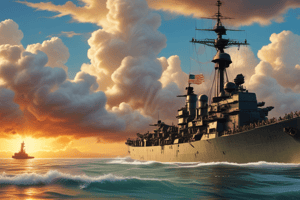Podcast
Questions and Answers
When did the US drop an atomic bomb on Hiroshima?
When did the US drop an atomic bomb on Hiroshima?
- June 1942
- 6 August 1945 (correct)
- 14 August 1945
- 7 December 1941
What was the official US justification for dropping the atomic bombs?
What was the official US justification for dropping the atomic bombs?
- To force the Japanese government to surrender (correct)
- To demonstrate military strength to the Soviet Union
- To gain control of Southeast Asia
- To retaliate for the Pearl Harbor attack
What was the significance of the attack on Pearl Harbor?
What was the significance of the attack on Pearl Harbor?
- It marked Japan's victory in World War II
- It led to the invasion of Europe
- It strengthened the US Pacific Fleet
- It initiated the Pacific War (correct)
What was Japan's aim in attacking Pearl Harbor?
What was Japan's aim in attacking Pearl Harbor?
How did the dropping of atomic bombs impact Japan?
How did the dropping of atomic bombs impact Japan?
Flashcards are hidden until you start studying
Study Notes
The Atomic Bombings of Japan
- The US dropped an atomic bomb on Hiroshima on August 6, 1945.
- The US dropped a second atomic bomb on Nagasaki on August 9, 1945.
US Justification for Dropping the Atomic Bombs
- The official US justification for dropping the atomic bombs was to quickly end World War II and avoid the potential loss of life on both sides that an Allied invasion of Japan would entail.
The Attack on Pearl Harbor
- Japan launched a surprise attack on Pearl Harbor on December 7, 1941, drawing the US into World War II.
- The significance of the attack on Pearl Harbor was that it marked the beginning of the US's direct involvement in World War II.
Japan's Aims in Attacking Pearl Harbor
- Japan's aim in attacking Pearl Harbor was to prevent the US Pacific Fleet from interfering with Japanese expansionist policies in Southeast Asia.
The Impact of the Atomic Bombings on Japan
- The dropping of atomic bombs on Hiroshima and Nagasaki led to Japan's unconditional surrender on August 15, 1945, bringing an end to World War II.
- The atomic bombings had a profound impact on Japan, leading to widespread destruction, loss of life, and a reevaluation of the country's military policies.
Studying That Suits You
Use AI to generate personalized quizzes and flashcards to suit your learning preferences.




